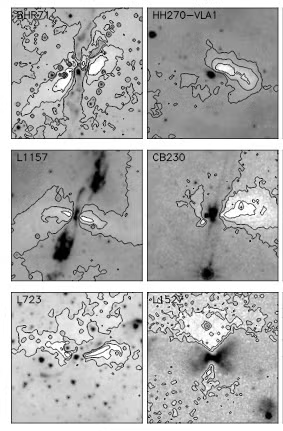 After a molecular cloud begins to fragment and forms what is called a “core”, with an embedded protostar, it can continue from its surroundings. Our simulations show (see How do star-forming clouds and star clusters arise?) as do many others, that accretion via filaments is quite common. Infall from (non-axisymmetric envelopes is known to promote the fragmentation of stars into multiple systems.
After a molecular cloud begins to fragment and forms what is called a “core”, with an embedded protostar, it can continue from its surroundings. Our simulations show (see How do star-forming clouds and star clusters arise?) as do many others, that accretion via filaments is quite common. Infall from (non-axisymmetric envelopes is known to promote the fragmentation of stars into multiple systems.
The images shown on the left are of protostars observed with the Spitzer Space Telescope. The contours show levels of extinction inferred from the extinction of background radiation at 8 microns wavelength. The dark areas show the bright central protostars and in many cases the scattered light which illuminates the cavities driven into the surrounding gas and dust by bipolar outflows. Not only do we observe filamentary clouds, presumed to be falling in toward the central protostar as shown in simulations, we also find that the envelopes are highly non-axisymmetric, in the sense of having much more material one on side than the other. Thus, it is not surprising that fragmentation into multiple systems is a common occurrence; it is to be expected as a result of the chaotic stuctures which form stars.
Research conducted by former graduate student John Tobin: Complex Structure in Class 0 Protostellar Envelopes
Another major factor undoubtedly leading to multiple stellar systems is massive infall with substantial angular momentum to form large circumstellar disks, which are susceptible to gravitational fragmentation. During the phase of infall to the disk, if the mass transport through the disk to the star cannot keep up with the mass addition, the disk can become gravitatkonally-unstable. Such pileup of mass in the disk seems to be required to explain the FU Orionis outbursts.
Gravitationally-unstable disks can exhibit two qualitatively different types of behavior. In one case, spiral arms develop which then both transport most of the mass inward while expanding the outer disk to conserve angular momentum. This process can be important in forming the central star when the magnetorotational instability is not important, as is generally the case for protostellar disks around low mass stars. However, if theregions of the spiral arms can cool efficiently, the disk can fragment into additional gravitationally-bound objects. Although GI has been suggested as a possible mechanism for forming (some) giant planets, it is more likely that such fragmentation produces more massive objects; i.e., companion stars, while the main mechanism for making planets probably relies on initial coagulation/accretion of solids.
The above figure shows a sequence of two-dimensional model calculations of protostellar disks with continuing infall from a protostellar envelope and allowing for heating of the disk by radiation from the central protostar. From top to bottom the mass infall is added at 50, 100, and 200 AU, while the infall rate increases from left to right, from 3 x 10^-6 solar masses per year to 3 x 10^-4 solar masses per year. Infall to larger radii and at higher rates promotes this fragmentation. The main result will eventually be the formation of companion low-mass stars, with some objects ejected and others remaining in a bound system. See Zhu+12.


